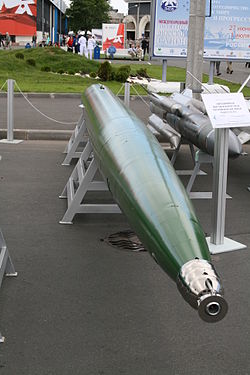VA-111 Shkval
| VA-111 Shkval | |
|---|---|

VA-111 Shkval
|
|
| Type | Supercavitating Torpedo |
| Place of origin | The Soviet Union |
| Service history | |
| In service | 1977–present |
| Used by | Russian Navy |
| Production history | |
| Designer | NII-24 research institute |
| Designed | 1960s–70s |
| Manufacturer | Tactical Missiles Corporation |
| Produced | 1977–present |
| Variants | Shkval 2 Shkval-E |
| Specifications | |
| Weight | 2,700 kg (6,000 lb) |
| Length | 8.2 m (26 ft 11 in) |
| Diameter | 533 mm (21 in) |
|
|
|
| Effective firing range |
Shkval: 7 km (4.3 mi) Shkval 2: From 11–15 km (6.8–9.3 mi) |
| Warhead | Conventional explosive or nuclear |
| Warhead weight | 210 kg (460 lb) |
|
|
|
| Engine | Solid-fuel rocket |
| Propellant | Solid-fuel |
| Speed | Launch speed: 50 knots (93 km/h; 58 mph) Maximum speed: in excess of 200 knots (370 km/h; 230 mph) |
|
Guidance
system |
GOLIS autonomous inertial guidance |
|
Launch
platform |
533 mm torpedo tubes |
The VA-111 Shkval (from Russian: шквал — squall) torpedo and its descendants are supercavitating torpedoes originally developed by the Soviet Union. They are capable of speeds in excess of 200 knots (370 km/h).
Design began in the 1960s when the NII-24 research institute was ordered to produce a new weapon capable of engaging nuclear submarines. The merger of the institute and GSKB-47 created the Research Institute of Applied Hydromechanics, who continued with the design and production of the Shkval.
Previously operational as early as 1977, the torpedo was announced as being deployed in the 1990s. The Shkval is intended as a countermeasure against torpedoes launched by undetected enemy submarines.
The VA-111 is launched from 533 mm torpedo tubes at 50 knots (93 km/h) before its solid-fuel rocket ignites and propels it to speeds of 200 knots (370 km/h). Some reports indicate that speeds of 250+ knots may be achieved, and that work on a 300-knot (560 km/h) version was underway. This high speed is due to supercavitation, whereby a gas bubble, which envelops the torpedo, is created by outward deflection of water by its specially-shaped nose cone and the expansion of gases from its engine. This minimizes water contact with the torpedo, significantly reducing drag.
Early designs may have relied solely on an inertial guidance system. The initial design was intended for nuclear warhead delivery. Later designs reportedly include terminal guidance and conventional warheads.
The torpedo steers using four fins that skim the inner surface of the supercavitation gas bubble. To change direction, the fin(s) on the inside of the desired turn are extended, and the opposing fins are retracted.
The torpedo is manufactured in Kyrgyzstan by a state-owned factory. In 2012 the Russian government asked for a 75% ownership of the factory in exchange for writing off massive Kyrgyz debt to Russia.
...
Wikipedia
